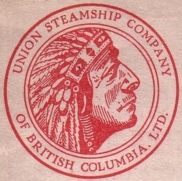Willapa Bay is a large shallow body of water near the Pacific Ocean in southwestern Washington. For a number of years before modern roads were built in Pacific County, Washington, the bay was used as the means of travel around the county, by powered and unpowered craft, including several steamboats.

Hyak was a wooden-hulled steamship that operated on Puget Sound from 1909 to 1941. This vessel should not be confused with the sternwheeler Hyak which ran on the extreme upper reach of the Columbia River at about the same time. The name means "swift" or "fast" in the Chinook Jargon.

Potlatch was a steamship which was operated on Hood Canal from 1912 to 1917, on Puget Sound from 1917 to 1937, although the vessel was little used after 1917.

Capilano was a steamship built in 1920 in British Columbia, which served until 1949.

Princess Beatrice was a steamship built for and owned by the marine division of the Canadian Pacific Railway (CPR). The ship served from 1903 to 1928 in the coastal waters of British Columbia. The ship also operated on Puget Sound on a route from Victoria, British Columbia to Seattle, Washington. Princess Beatrice was the first ship to operate in the year-round steamship service between Seattle and Victoria that was run by CPR from 1904 to 1959. This ship should not be confused with an earlier Princess Beatrice, built in Scotland in 1874, which served on the Atlantic coast of Canada.
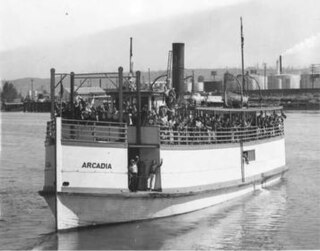
The steamboat Arcadia, built in 1929, was one of the last commercial steamboats placed into service on Puget Sound. The vessel later served as a prison tender under the name J.E. Overlade, and after that, as Virginia VI, as an excursion vessel.

SS Prince George was a passenger ship built in 1947 for the Canadian National Steamship Company, to ply the route from Vancouver, British Columbia, to Southeast Alaska.
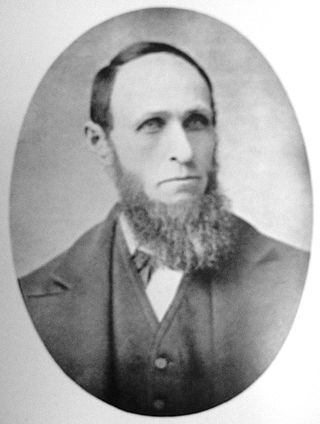
George Washington Shaver was an Oregon pioneer, and, with his sons, a founder of Shaver Transportation Company. He is typically referred to as George W. Shaver or G.W. Shaver.

Telephone was a sternwheel-driven steamboat built in 1884 by Captain Uriah Bonsor "U.B." Scott for service on the Columbia River. Reputedly the fastest steamboat in the world in its time, Telephone served on the Columbia River and San Francisco Bay. Telephone was rebuilt at least twice. The first time was after a fire in 1887 which nearly destroyed the vessel. The reconstructed and much larger second vessel was sometimes referred to as Telephone No. 2. The third vessel, Telephone No. 3, built in 1903 and using components from the second steamer was larger but little used during its time on the Columbia river.
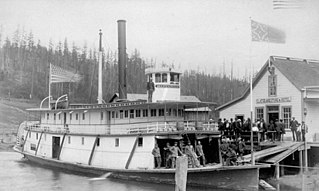
Manzanillo was a stern-wheel driven steamboat built at Portland, Oregon in 1881. Manzanillo was first run on the Columbia River route from Portland to Clatskanie, Oregon and way points along the river. The initial owner of the boat was the People's Freighting Company, but the Shaver family soon acquired control of the vessel, which became the first vessel of what is now Shaver Transportation Company.

Governor Newell was a sternwheel-driven steamboat that operated from 1883 to 1902 in the Pacific Northwest.

La Center was a small stern-wheel steamboat that operated from 1912 to 1931, mostly on the Lewis and Lake rivers in southwest Washington, on a route to and from Portland, Oregon along the lower Columbia and lower Willamette rivers.

Jessie Harkins was a propeller-driven steamboat that operated on the Columbia River in the USA starting in 1903. It was rebuilt at least twice. Originally, Jessie Harkins was one of the larger gasoline-engined vessels to operate on the Columbia River. Jessie Harkins was built for the Harkins Transportation Company.

Joseph Kellogg was a stern-wheel driven steamboat that operated on the Willamette, Columbia, and Cowlitz rivers for the Kellogg Transportation Company. It was named after the company's founder, Joseph Kellogg (1812-1903). The sternwheeler Joseph Kellogg was built in 1881 at Portland, Oregon.

Undine was a sternwheel-driven steamboat that operated from 1887 to 1935 on the Columbia and lower Willamette rivers. From 1935 to 1940 the same vessel was operated under the name The Dalles.

Nahcotta was a steamboat operated from 1898 to 1928 on a route from Astoria, Oregon to Ilwaco, Washington, and then, from 1908 on, from Astoria to Megler, Washington. Nahcotta ran on the same route for its entire service life, and for much of that time was commanded by Capt. Tom Parker, who started his marine career as a deckhand and who had only three months of formal education.

International was a stern-wheel driven steam boat that operated on Kootenay Lake in British Columbia from 1896 to 1908. International was owned by a Canadian subsidiary of the Great Northern Railway and was involved in sharp competition, including steamboat racing, with similar vessels owned by the Canadian Pacific Railway.
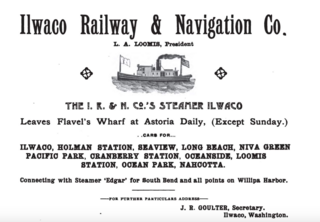
Ilwaco was a small riverine and coastal steamship built in 1890 which was operated as a passenger vessel for the Ilwaco Railway and Navigation Company, and later served in other roles, including tow and freight boat, cannery tender and fish packing vessel. Ilwaco was originally named Suomi.

Telegraph was a sternwheel-driven steamboat built in 1903 in Everett, Washington. Except for the summer of 1905, from 1903 to 1912, Telegraph served in Puget Sound, running mainly on the route from Seattle to Everett, and also from Seattle to Tacoma and Olympia, Washington.

The Callendar Navigation Company, sometimes seen as the Callendar Transportation Company, started in business in the early 1900s. Callendar was formed in the early 1900s, and was based in Astoria, Oregon. Callender was to become one of six large towing companies of the Columbia and Willamette rivers in the early decades of the 1900s, the others being Shaver Transportation, Smith Transportation, Hosford, Knappton Towing Co., and Willamette and Columbia River Towing Co. In 1922, Callendar Navigation merged with Knappton Towboat Co., which existed, with a name change in 1990, and which became part of Foss Marine in 1993.
